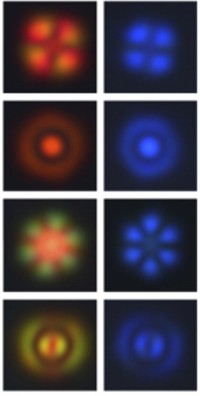Applications
Below, we present few examples where we used the LBSA and its features to show the versatility of the presented software.
1) Adaptive optics / beam correction
The LBSA correction and transformation features are the outcome of our work, where we proposed the objective criteria to evaluate the quality of the laser beam. For this purpose we firstly corrected the beam using the combined correction algorithms: SLM surface correction and the iterative G-S correction based on the optical vortex image. Based on these results we evaluated the beam through the exploration of the vortex trajectory - movement of the vortex point caused by the shift of its generating element. In this case, the vortex was generated by the SLM and such movement was controlled through the translation of the hologram.

2) Manual aberration control
In the same work we evaluated the quality of various beams through the proposed optical vortex trajectory. To manually controll the aberration value we incorporated the LBSA Zernike component that modified the quality of the beam in a cotrollable manner. Below we present exemplary beams, distrubed by the artificially introduced aberration:

Similar concept we repeated in this work. Here we proposed simple geometric metrics to evaluate such quality. Each time particular distrubance was introduced through the LBSA and its functions. Below we show various stages that modified the beam:

3) Fiber modes excitation
In this paper we used the software to selectively excite higher-modes in optical fibers. The purpose of this was to measure the chromatic dispersion in single mode optical fibers, which enables dispersion measurements in higher-order modes over a wide spectral range. The examplary image presents few of the excited modes without (left) and with (right) filter, to show the wide spectral range of the excited mode.
